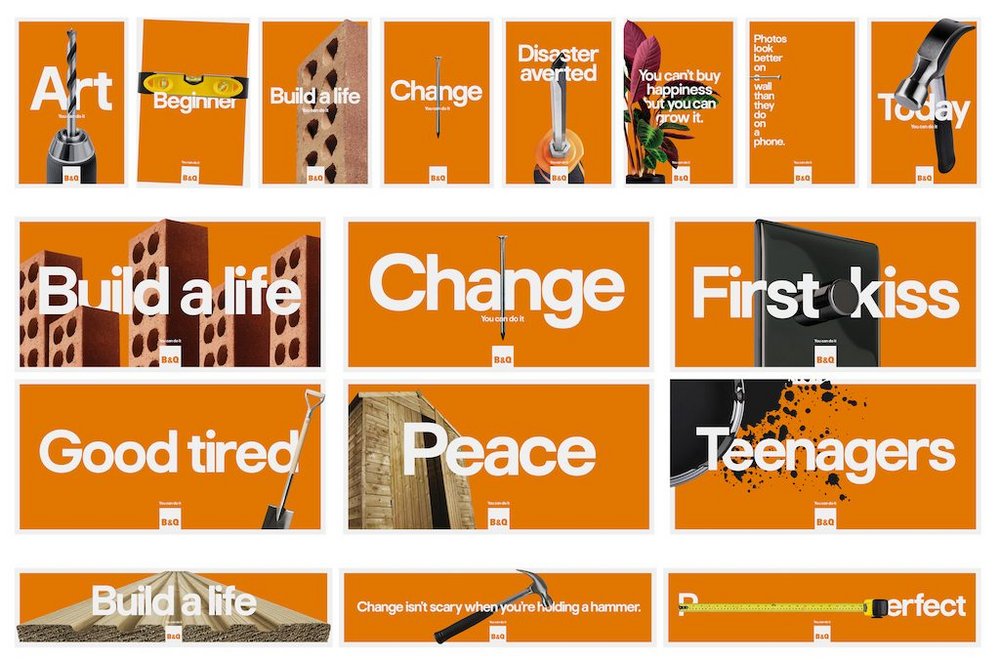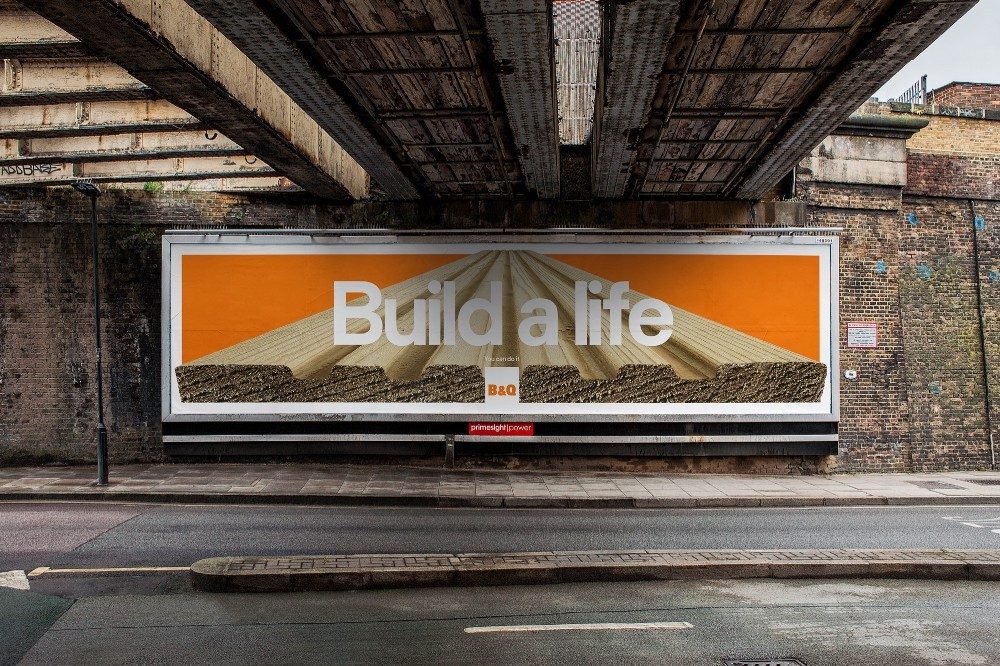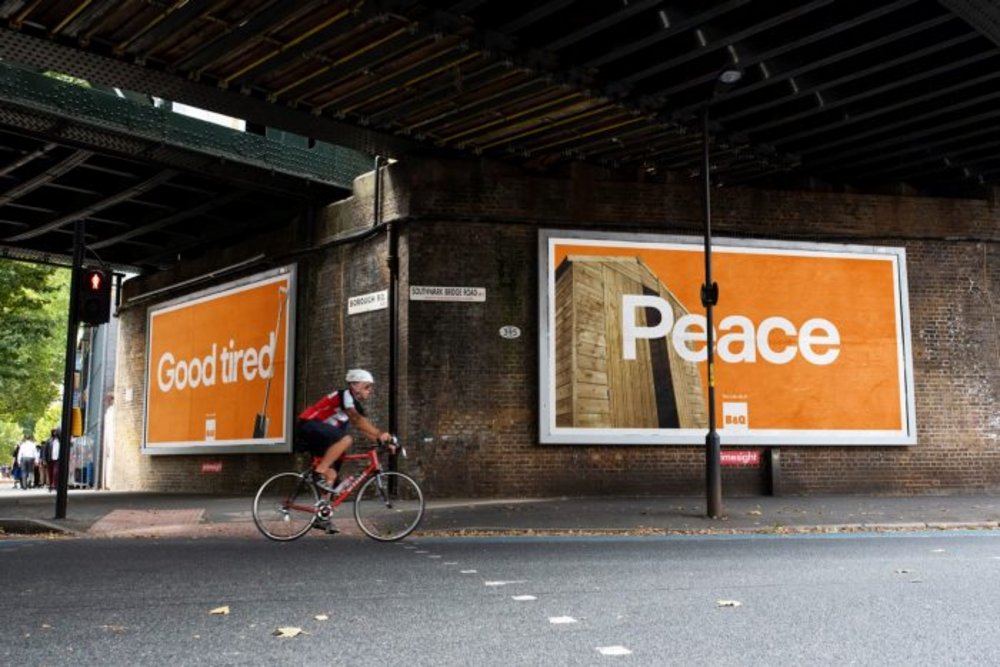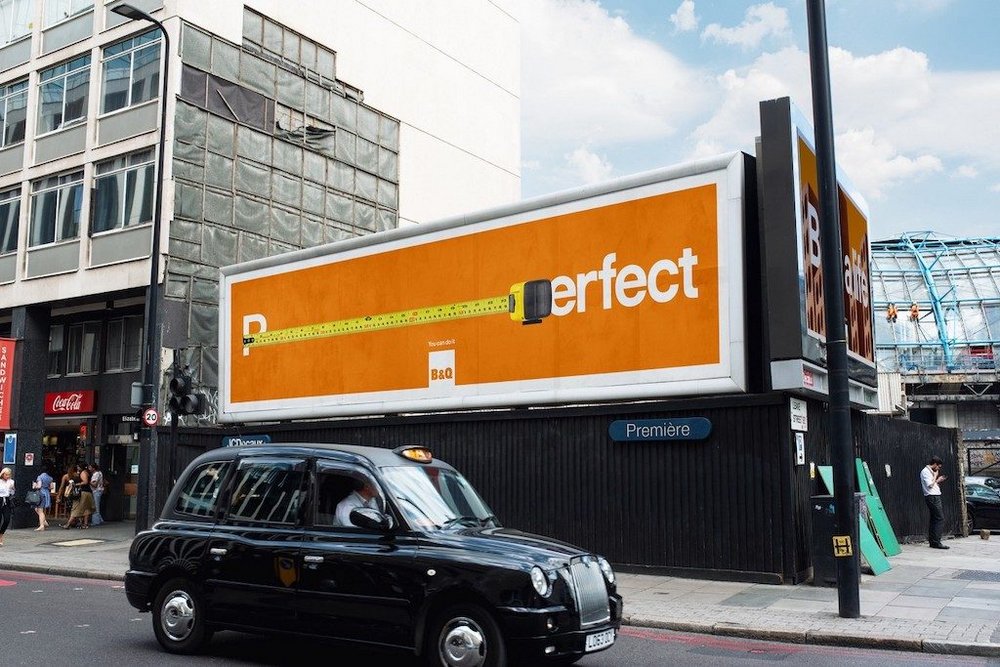Insight & strategy
The strategy behind B&Q’s Build a Life campaign /
How Uncommon helped the UK's leading home improvement retailer connect with homeowners during the pandemic by capturing the emotional spirit of DIY
Contagious I/O
/
Contagious recently covered B&Q’s new campaign, Build a Life. Launched with a film made up of real home videos from families across the UK, the campaign reminds us that anyone can change their home to make life better.
Created with Uncommon, London, the film was followed by a series of large-scale billboards in major cities in the UK, which reflect life moments and how home improvement can shape them.
The out-of-home elements blend B&Q’s classic orange with statements inspired by life at home and home improvement, while the ad is narrated by Game of Thrones actor Rory McCann, and ends with a nod to B&Q’s famous tagline, ‘You can do it’.
We spoke to Uncommon’s head of planning, Tobey Duncan, to find out what inspired the change in tone for the DIY retailer, how it came to reflect the mood of the UK post-lockdown, and how to achieve emotional storytelling authentically and with relevance.
How long has Uncommon been working with B&Q?
We started working with B&Q last December following a competitive pitch. The retailer had a relatively new team – including a CEO, CMO and Director of Merchandising & Commercial Planning who were all under two years in their seats – the brand came to us with a really clear brief: ‘How can B&Q get their mojo back?’
B&Q have been running for over 50 years; its an iconic UK brand and has played a huge part in building our home lives but it recognised that it had lost its identity along the way and wanted our help to redefine what it represents. We wanted to help B&Q drive emotional connection back to the brand and reinstate its meaningful place within UK culture.
Where does the brand sit in the market?
It obviously has its classic competitors, what the brand calls the ‘sheds’ – these are companies such as Homebase and Wickes. That is still the brand’s main competition, but there’s a whole bunch of other businesses eyeing up B&Q’s market these days. Most notably Amazon, but also the specialists who are dedicated experts in niche markets, whether that’s Patch Plants or companies that sell specific types of radiators, kitchens and so on.
The big challenge B&Q face is the increase in the sheer number of people vying for the DIY and home improvement market. There’s never been so many brands so standing out has never been more important.
What does B&Q’s target audience look like?
It really is an incredibly broad audience. From first time buyers, to families renovating and even to those renting their homes. B&Q connect with so many different types of homes.
The big leap for us and B&Q (I actually don’t think this was a big leap for consumers) was to reconnect B&Q with what home improvement and DIY means.

Tobey Duncan, Uncommon
Did you receive a specific brief for Build a Life?
B&Q had seen a lot of their key brand measures under pressure and were really looking to reinstate its place in the UK. The brand was aware that its the market leader and wanted to reclaim a place at the top of people’s minds and hearts.
Which key metrics will you be tracking with this campaign?
Brand health broadly, and a whole bunch of stuff within that, but it’s really about how people feel about the brand. B&Q have strong awareness and sales are doing well too. But the stuff in the middle – the way people feel about the brand – is under more pressure these days. We hope this work brings meaning back to the retailer and reclaims its role in people’s lives.
What was your initial response to the brief?
At the beginning we just said: ‘We need to get people feeling differently about this brand.’ The big leap for us and B&Q – but I actually don’t think this was a big leap for consumers – was to reconnect B&Q with what home improvement and DIY means. The thing that was really obvious to us is that all the competition talks about this industry as a category of chores like – you’re fixing broken things; your house is against you and your house is inadequate.
And if you read anything about the way people feel about their homes or spend any time actually talking to people about DIY– you’ll find that it’s not about fixing stuff at all. It’s about creating stuff. It’s about changing things. And we just thought that was incredibly powerful. We wanted to build the brand around that very sentiment. As the number one DIY retailer, B&Q can really stand for the transformational power of DIY. This really helped the tone of the campaign come to life. We wanted ‘Build a Life’ to tap into the fundamental truths about our homes and reflect the role B&Q has played in transforming the UK’s homes for the past 50 years.
Tobey Duncan, Uncommon

The campaign references a few figures from a YouGov survey on UK homeowners – how did that influence the direction of the project?
That’s something that actually came afterwards. Rather than that being an input into the initial strategy and research, the survey was led primarily by B&Q’s PR agency. It was inspired by our thinking, as a means to dig deeper into our concept.
In our initial process, Uncommon did a lot of reading around how people view their homes in Britain. We then actually went into the homes of a lot of different people who’ve recently done DIY projects, to ask questions and investigate. We really needed to understand what home improvement meant to them and explore the role DIY played in helping change their lives.
How did you ensure this emotional tone would come across as relevant and authentic coming from a home improvement retailer?
With any creative process there’s always that part which feels a little bit risky. The thing that was really encouraging, is there was this massive disconnect between the way the category would talk about DIY, and the way real people would talk about it at home. So, while it seems like a radical departure from the category, I think we’ve just moved much closer to what consumers view and see.
And given so many people in the UK have been going to B&Q stores for home improvements, reconnecting the brand with that didn’t seem like a massive overreach, hopefully it hasn’t come across as one. I think if we were making something up like, ‘We want people to see DIY like this, because no one sees it like that at the moment’ – that might have been a bit more nerve-wracking.
But given we weren’t making something up, that we were just paying tribute to the way people saw DIY and capturing that truth, I think we just wanted to be quite respectful and honest about it. So, that was probably more our consideration than worrying about getting too caught up in ourselves. But that’s always a risk, isn't it?

Where did the idea come from to use real home videos?
We were super mindful that we were going to come out and make a claim about people’s lives – it felt right to do that in the most authentic manner. Capturing real life moments, using real people’s archive footage, to represent a genuine portrait of British homes and how they have been improved across the years – felt like the most truthful representation of our idea.
The film shows snippets from 69 families across the 69 cities that make-up the UK. And through those videos we see the ups and downs of life at home and how home improvement can shape them.
Also, the idea of making our production bigger than just a way to generate ads, but almost developing an archive which then would allow us, throughout the year, to create things that could be of real cultural interest was really something we got excited about.
And how did you actually go about collecting them?
It was done as part of a TV production process. In the same way you might street cast, there was a casting partner who connected us with a real home from every city in the UK. Each family would share their film archives of family and home life videos. We digitised them – and that still exists as a key resource. The hope is to create more ads out of that collection next year, but also make something a little more remarkable, like a short-form documentary for example.
Tobey Duncan, Uncommon
We thought the tone and subject matter of Build a Life chimes so well with the mood of the UK in this pandemic – was this planned or just plain lucky?
We were kind of concerned talking about home, being nostalgic – evoking the past might even have been a tricky thing. So, it’s lovely that it has felt more relevant maybe now as a consequence of that.
But there’s also some lucky coincidence as well. There were definitely conversations about whether the opposite might happen – whether home footage might be too familiar after Covid-19, or whether people wouldn’t want to think about the past or home, because we’re in a really different relationship with all those things at the moment.

Besides pausing the campaign, what were the challenges of producing this?
Like every other business, B&Q were navigating their way through lockdown restrictions. Not knowing whether they were going to have increased demand or less demand and what staffing challenges may arise. A lot of our conversations were dominated by the unknown and how best we could launch this campaign in these new times.
It’s funny, we were also actually a little worried that other brands were going to have a similar stylistic approach – making work with ‘found footage’ – due to the lack of shooting opportunities caused by the initial lockdown restriction around production.
Tell us a bit about the media plan – we saw the film was followed by some large-scale out-of-home elements a few days later.
There are definitely two central components to this – the film and the OOH series. There’s social and digital also running alongside it, but for us it was really important our film and OOH embodied the new purpose boldly.
We wanted the brand to say its message with pride – we didn’t want it hidden on an Instagram feed, or dripped-fed across media over many months. We wanted big definitive launch moments, so massive poster sites across the UK and 60-second TV spots were the way to go. The idea is that this will then be followed by more targeted campaigns this year and next.
Tobey Duncan, Uncommon

It definitely still feels distinctively B&Q despite the tonal change – was that a priority?
That’s great to hear. We were trying to be more loyal to how people think about the brand, than the [B&Q] ads of the past. I think there is a real fondness for B&Q and stitching it into a story about the nation and how we see ourselves didn’t feel like a massive overreach. The brand has maybe oscillated a little bit as to what it’s about creatively, but within the business, there is a real clear sense of direction.
There were some existing amazing assets to play with – the recognisable brand colour orange and the line ‘You can do it’. We felt that these were important to honour and fully embrace in the new campaign.
‘You can do it’ has never been a more powerful thought. The idea that you can build a room, a house, a life. We didn’t want to give B&Q another end line, we just wanted to clarify what we were talking about. So, ‘You can do it’ became ‘You can create a life and a home and the things that you want in this world’.
It’s early days, but have you got any sense of how people have engaged with the campaign?
Not enough to pat ourselves on the back just yet, but we’ve been really encouraged by the response internally at B&Q. It is a massive employer and its really keen to share and bring every employee along on this journey. Anecdotally and on Twitter, we’ve also had some really positive feedback from the industry and consumers – which is always nice to see so soon after a launch.

What have you learned from this process?
The thing that really struck me about this campaign process is if you look at the advertising around DIY, you only get one specific view around it – it’s all about chores. The sentiment being that our houses are falling apart; they’re conspiring against us. But if you speak to people, the stuff they are trying to achieve is so much more interesting and profound. I was just blown away by how personal these stories are. When you look at a category that’s never really spoken about the power of home but is so connected to it – that was really an amazing opportunity and conversation for B&Q to own.

Want to hear more from Uncommon? Then get your tickets for Most Contagious, where the Uncommon founders, Natalie Graeme, Lucy Jameson and Nils Leonard, will explain how they’ve built an agency that’s gone from 0-60 in just three years and nailed the mood of 2020 with a succession of campaigns selling everything from telly to mental health to, well, nails.
Want more of the same? /
We don’t just write about best-in-class campaigns, interviews and trends. Our Members also receive access to briefings, online training, webinars, live events and much more.







